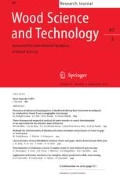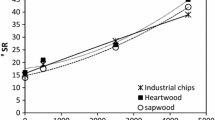Abstract
The importance of eucalypt as a raw material for pulping is steadily growing. Eucalyptus globulus was compared with European hardwood species using two alkaline pulping processes, kraft and alkaline sulfite, anthraquinone pulping (ASA), which is a recently developed modified alkaline sulfite process. All cooks were performed to similar kappa numbers. Poplar cooks resulted in the highest yields followed by eucalypt and birch which were on the same level. Yield of beech pulps was definitely lower. ASA pulps show a moderate higher yield due to the less alkaline pH-profile of the cooking liquor. This yield advantage was maintained and even enhanced after TCF-bleaching. The bleaching response of all pulps was excellent. The birch pulps had the highest tensile strength followed by the poplar and beech pulps. Surprisingly eucalypt pulps had the lowest tensile strength. But this was compensated by the very good tear index of eucalypt pulps. The runnability factor, as an index for the overall strength potential, was on the same level for all pulps. Due to the higher hemicellulose content of the ASA pulps their tensile strengths were higher, but tear strengths lower compared to the kraft pulps. The different morphology of the hardwoods investigated resulted in different volumes and light scattering coefficients of the corresponding pulps.






Similar content being viewed by others
References
Heikkurinen A, Levlin J, Paulapuro H (1991) Principles and methods in pulp characterization—basic fiber porperties. Paperi ja Puu Paper Timber 79(5):411–417
Hunger G (1983) Hemicellulosen in der Papierherstellung. Das Papier 37(12):582–590
Paavilainen L (2002) Fiber structure. In: Mark R, Habeger C, Borch J, Lyne M (eds) Handbook of physical testing of paper, Vol 1 Marcel Dekker, New York, pp 699–726
Patt R, Kockmann C, Kordsachia O, Geisenheiner A (2004) Pulping of beech wood using different acid and alkaline pulping processes—a comparison. Ipw Int Paperworld Das Papier 1:41–47
Patt R, Kordsachia O, Aalto E-M, Connor E (2005) Alkalische Sulfitverfahren zur Herstellung von Zellstoffen mit spezifischen Eigenschaften. Ipw Int Paperworld Das Papier (in press)
Author information
Authors and Affiliations
Corresponding author
Additional information
Dedicated to Prof. Dr. Dr. h. c. mult.Walter Liese on the occasion of his 80th birthday.
Rights and permissions
About this article
Cite this article
Patt, R., Kordsachia, O. & Fehr, J. European hardwoods versus Eucalyptus globulus as a raw material for pulping. Wood Sci Technol 40, 39–48 (2006). https://doi.org/10.1007/s00226-005-0042-9
Received:
Published:
Issue Date:
DOI: https://doi.org/10.1007/s00226-005-0042-9




